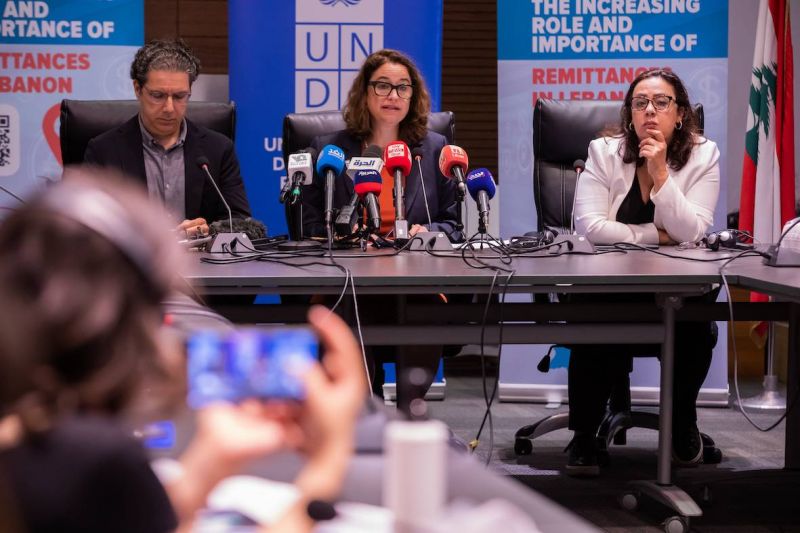
Sami Atallah, left, Melanie Hauenstein and Kawthar Dara present the UNDP's latest report. (Credit: UNDP)
BEIRUT — Remittances made up 37.8 percent of Lebanon’s GDP in 2022, a new report by the United Nations Development Programme (UNDP) says.
Lebanon has the highest remittance-to-GDP ratio in the Middle East and North Africa and globally is second only to the tiny island nation of Tonga. As recently as 2019 this figure was below 15 percent of GDP.
Despite the large jump relative to GDP, the absolute value of remittances has remained stable over the past decade, hovering between $6 billion and $7 billion per year, indicating that the increased weight of remittances as a component of GDP is largely driven by the shrinking Lebanese economy. Lebanon’s nominal GDP has shrunk from $54.90 billion in 2018 to $17.95 billion in 2023, according to World Bank estimates.
The stability in the value of remittances is partly underpinned by the continuous overseas emigration of Lebanese, the report finds, offsetting the tendency for emigrant remittances to shrink over time as expats develop stronger ties in their new home and weaker ties with their country of origin.
Authored by Sami Atallah, director of the local think tank The Policy Initiative, the UNDP report finds that Gulf countries are the leading source of remittances to Lebanon, making up 48 percent of the total, with North America a distant second at 16 percent and Western Europe and Africa tied for third at 14 percent.
Amid the economic and financial crisis, Lebanese emigrants have increasingly been using informal channels to remit their earnings, with most arriving in the pockets and suitcases of expats traveling to Lebanon and, to a much lesser extent, through wire transfer companies like OMT.
The report cites estimates that, in 2021, 70 percent of remittances arrived in cash, 30 percent via money transfer companies, and approximately zero percent through Lebanon’s zombie banks, which are known to charge high transfer and withdrawal fees.
The cost of transferring money to Lebanon is 10.8 percent, far higher than the six percent global average, constituting a regressive tax on households using family remittances to make essential daily purchases.
Indeed, one of the most significant changes brought about by the crisis — besides the abandonment of formal remittance channels — is in how families spend the monies received. Previously families often used remittances to fund healthcare and education, in addition to food and housing. Economists consider healthcare and education investments in “human capital.”
After the onset of the crisis the vast majority of remittance income was being used to support basic day-to-day purchases of necessities like food and “no longer fed human capital investment,” the report said.
Commenting on the reports findings Thursday, UNDP Resident Representative Melanie Hauenstein called it “alarming, as one of Lebanon’s comparative advantages is its human capital. The dwindling investments in health and education will have a detrimental impact on Lebanon’s development prospects.”
The major unresolved question about remittances remains exactly how many Lebanese households are benefitting from them.
The report notes that official statistics from 2018 and 2022 found that 10 percent and 15 percent of households received remittances in each year, respectively.
“It is worth noting, however, that remittances may be under-reported in national surveys,” the report cautions. “The substantive size of remittance inflows, at an aggregate level, suggests that the number of people benefiting from these inflows might be well above the figure of 15 percent.”
A UNDP survey conducted during the first quarter of 2022 found that 29 percent of respondents reported receiving remittances for the first time in response to the crisis.